
Tàrrega is a town and municipality located in the Urgell comarca, Province of Lleida, Catalonia. According to the 2011 census (INE), the town has a population of 16,676.

Vic is the capital of the comarca of Osona, in the province of Barcelona, Catalonia, Spain. Vic is located 69 km (43 mi) from Barcelona and 60 km (37 mi) from Girona.

The Cathedral of the Holy Cross and Saint Eulalia, also known as Barcelona Cathedral, is the Gothic cathedral and seat of the Archbishop of Barcelona, Catalonia, Spain. The cathedral was constructed from the thirteenth to fifteenth centuries, with the principal work done in the fourteenth century. The cloister, which encloses the Well of the Geese was completed in 1448. In the late nineteenth century, the neo-Gothic façade was constructed over the nondescript exterior that was common to Catalan churches. The roof is notable for its gargoyles, featuring a wide range of animals, both domestic and mythical.
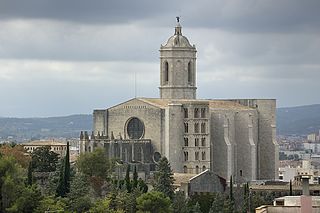
Girona Cathedral, also known as the Cathedral of Saint Mary of Girona, is a Roman Catholic church located in Girona, Catalonia, Spain. It is the seat of the Roman Catholic Diocese of Girona. The cathedral's interior includes the widest Gothic nave in the world, with a width of 23 metres (75 ft), and the second-widest of any church after that of St. Peter's Basilica. Its construction was begun in the 11th century in the Romanesque architectural style, and continued in the 13th century in the Gothic style. Of the original Romanesque edifice only the 12th-century cloister and a bell tower remain. The second bell tower was completed in the 18th century.
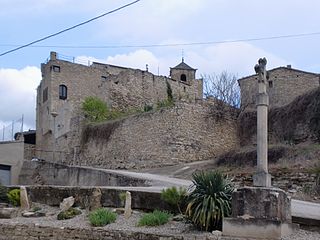
Vallfogona de Riucorb is a municipality and village in the comarca of the Conca de Barberà in central Catalonia, Spain. It is situated in the Comalats range in the north of the comarca, with the Cap de Cans rising to 759 m. Vallfogona village is built on the south bank of the Corb river.

The Monastery of Santa Maria de Ripoll is a Benedictine monastery, built in the Romanesque style, located in the town of Ripoll in Catalonia, Spain. Although much of the present church is 19th century rebuilding, the sculptured portico is a renowned work of Romanesque art.

Saint Olegarius Bonestruga was the Bishop of Barcelona from 1116 and Archbishop of Tarragona from 1118 until his death. He was an intimate of Ramon Berenguer III, Count of Barcelona, and often accompanied the count on military ventures.

Alcanar is a Spanish municipality of the Catalan comarca of Montsià, in the Tarragona province. It is a coastal town on the Mediterranean Sea. The Serra del Montsià range and its foothills rise above the town and its surroundings. According to data from 2006 its population is 9,620 inhabitants, although this increased the next year, to 9,969. It is the southernmost town in Catalonia, located just north of the border with the municipality of Vinaròs which is in the province of Castellón and part of the region of Valencia.

Òrrius is a village and municipality in the comarca of Maresme in the province of Barcelona and autonomous community of Catalonia, Spain. The municipality is delimited by La Roca del Vallès to the North, Vilassar de Dalt to the South East, Argentona to the south, and Cabrils to the southwest.
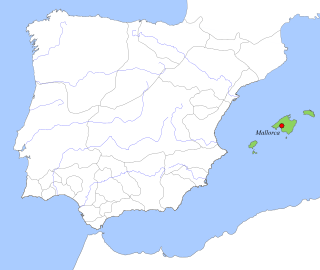
In 1114, an expedition to the Balearic Islands, then a Muslim taifa, was launched in the form of a Crusade. Founded on a treaty of 1113 between the Republic of Pisa and Ramon Berenguer III, Count of Barcelona, the expedition had the support of Pope Paschal II and the participation of many lords of Catalonia and Occitania, as well as contingents from northern and central Italy, Sardinia, and Corsica. The Crusaders were perhaps inspired by the Norwegian king Sigurd I's attack on Formentera in 1108 or 1109 during the Norwegian Crusade. The expedition ended in 1115 in the conquest of the Balearics, but only until the next year. The main source for the event is the Pisan Liber maiolichinus, completed by 1125.

Els Hostalets de Pierola is a Spanish municipality situated in the Autonomous Community of Catalonia, province of Barcelona, Spain.

Vallbona Abbey, otherwise the Monastery of Santa Maria de Vallbona, is a Cistercian nunnery in Vallbona de les Monges, in the comarca of Urgell, Catalonia, Spain. Founded in the early 12th century, and built between then and the 14th century, it is one of the most important monastic sites in Catalonia. Its church represents an example of transition between Romanesque and Gothic architecture. The abbey was declared a national monument on 3 June 1931.

El Molar is a municipality in the comarca of Priorat, Tarragona Province, Catalonia, Spain.

Alcanó is a village in the province of Lleida and autonomous community of Catalonia, Spain.
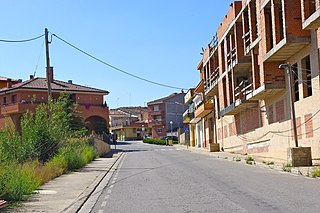
Alcoletge is a village in the province of Lleida and autonomous community of Catalonia, Spain.
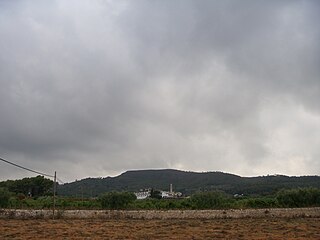
Albinyana or Albiñana is a village in the province of Tarragona and the autonomous community of Catalonia, Spain. It belongs to Tarragona in the Baix Penedès region. According to data from 2009, its population was 2,275.

Barberà de la Conca is a village in the province of Tarragona and autonomous community of Catalonia, Spain.
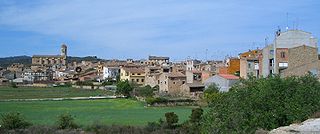
Blancafort is a municipality in the province of Tarragona and the autonomous community of Catalonia, Spain.
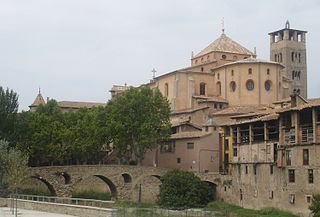
Vic Cathedral, officially the Cathedral of St. Peter the Apostle, is a Roman Catholic cathedral in Vic, Catalonia, Spain. It is the seat of the Diocese of Vic.

The House of Montcada is an aristocratic and noble Spanish Catalan House.






















